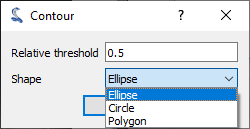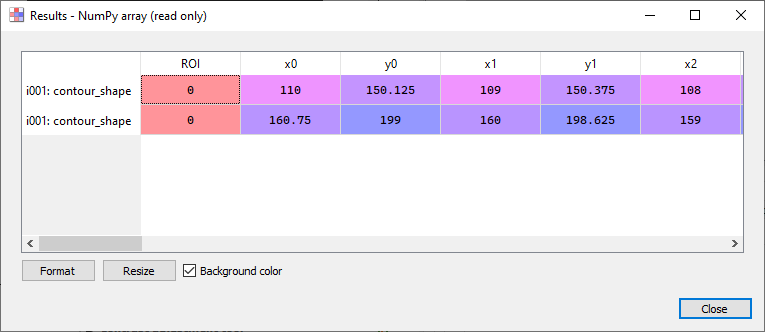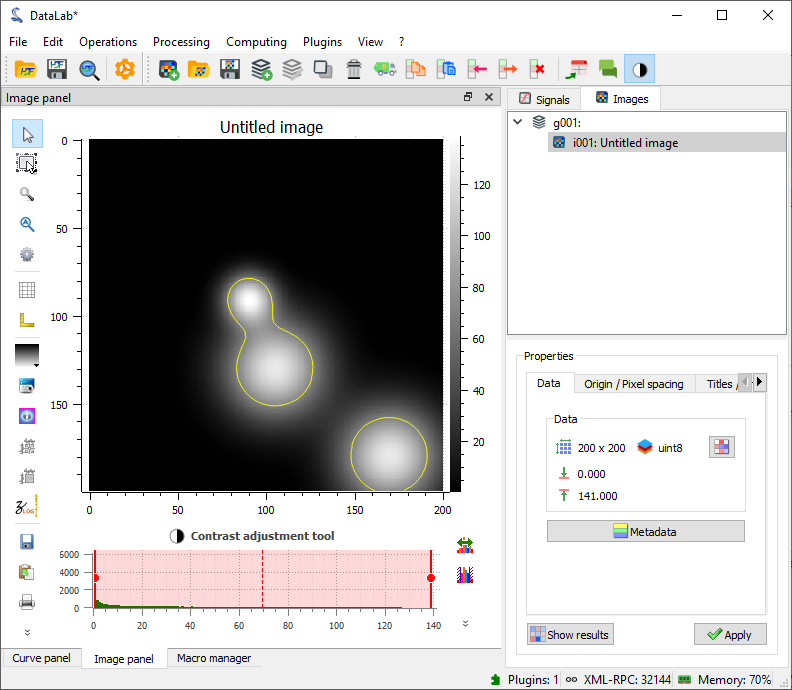Contour Detection#
DataLab provides a “Contour Detection” feature which is based on the marching cubes algorithm.

Contour detection parameters.#
- How to use the feature:
Create or open an image in DataLab workspace
Eventually create a ROI around the target area
Select “Contour detection” in “Analysis” menu
Enter parameter “Shape” (“Ellipse”, “Circle” or “Polygon”)
Optionally, enable “Create regions of interest” to automatically create ROIs around each detected contour:
Choose ROI geometry: “Rectangle” or “Circle”
ROI size is automatically calculated based on the minimum distance between detected contours (to avoid overlap)
This feature requires at least 2 detected contours
Created ROIs can be useful for subsequent processing on each contour area

Contour detection results (see test “contour_app.py”)#
- Results are shown in a table:
Each row is associated to a contour
First column shows the ROI index (0 if no ROI is defined on input image)
Other columns show contour coordinates: 4 columns for circles (coordinates of diameter), 8 columns for ellipses (coordinates of diameters)

Example of contour detection.#
- The contour detection algorithm works in the following way:
First, iso-valued contours are computed (implementation based on skimage.measure.find_contours.find_contours)
Then, each contour is fitted to the closest ellipse (or circle)
Feature is based on get_contour_shapes function from sigima.tools module:
def get_contour_shapes( data: np.ndarray | ma.MaskedArray, shape: ContourShape = ContourShape.ELLIPSE, level: float = 0.5, ) -> np.ndarray: """Find iso-valued contours in a 2D array, above relative level (.5 means FWHM). Args: data: Input data shape: Shape to fit. Default is ELLIPSE level: Relative level (default: 0.5) Returns: Coordinates of shapes fitted to contours """ # pylint: disable=too-many-locals contours = measure.find_contours(data, level=get_absolute_level(data, level)) coords = [] for contour in contours: # `contour` is a (N, 2) array (rows, cols): we need to check if all those # coordinates are masked: if so, we skip this contour if isinstance(data, ma.MaskedArray) and np.all( data.mask[contour[:, 0].astype(int), contour[:, 1].astype(int)] ): continue if shape == ContourShape.CIRCLE: model = measure.CircleModel() if model.estimate(contour): yc, xc, r = model.params if r <= 1.0: continue coords.append([xc, yc, r]) elif shape == ContourShape.ELLIPSE: model = measure.EllipseModel() if model.estimate(contour): yc, xc, b, a, theta = model.params if a <= 1.0 or b <= 1.0: continue coords.append([xc, yc, a, b, theta]) elif shape == ContourShape.POLYGON: # `contour` is a (N, 2) array (rows, cols): we need to convert it # to a list of x, y coordinates flattened in a single list coords.append(contour[:, ::-1].flatten()) else: raise NotImplementedError(f"Invalid contour model {model}") if shape == ContourShape.POLYGON: # `coords` is a list of arrays of shape (N, 2) where N is the number of points # that can vary from one array to another, so we need to padd with NaNs each # array to get a regular array: max_len = max(coord.shape[0] for coord in coords) arr = np.full((len(coords), max_len), np.nan) for i_row, coord in enumerate(coords): arr[i_row, : coord.shape[0]] = coord return arr return np.array(coords)